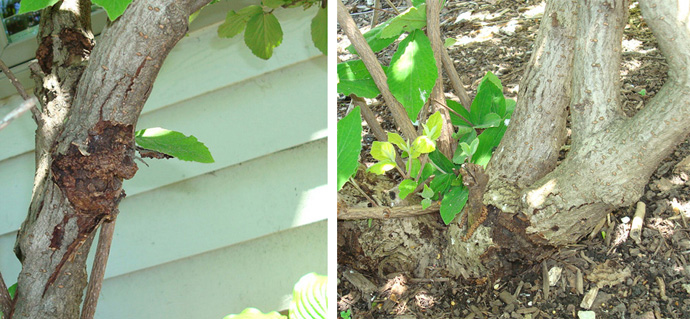Issue 8, June 12, 2009
Cankers--Botryosphaeria and Others
Cankers are dead areas on plant stems. They may appear sunken, shriveled, off-color, bumpy, or even wet. Pathologists can tell you the fungus (or bacterium in some cases) associated with a particular canker, but the canker would not occur without a mechanical injury or some form of plant stress. Many hosts have a regular group of canker fungi associated with the genus. For example, oaks are commonly affected with Botryosphaeria canker, spruce with Cytospora canker, and stressed pines with Diplodia canker. The literature refers to the fungi or bacteria associated with the cankers as secondary invaders, opportunistic pathogens, or stress pathogens. Obviously, some canker fungi are more aggressive than others.
The University of Illinois Plant Clinic has seen quite a few cases of cankered wood on tree samples submitted so far this season. That is to be expected, especially considering the flooding and drought stressed areas of the state over the past two years. Additionally, in the winters of 2007-8 and 2008-9 woody plants have been brought out of winter dormancy only to be affected with a late freeze. So, without even considering site stress, environmental stress has predisposed plants to canker problems.

The images show cankers on the stem (left) and trunk (right) of a viburnum plant. Images were taken by arborist, Judy Markowski, to accompany a sample sent to the Plant Clinic. Often we receive the peripheral stems and leaves in such a case because large cankers cannot be sent. Sometimes the images and part of the face of the canker will help with the diagnosis. Without the images we would be left to speculate or provide an inaccurate diagnosis. Interestingly, these images also pointed out something we could not detect with the sample. When entomologist, Phil Nixon, examined the images, he stated that the damage was typical of viburnum borer. This insect causes damage below the soil line. Evidently the fungal canker we found had followed insect damage.
Often cankered wood is removed from the tree or shrub as a means of preventing spread within the plant. Other times, as with the canker at the base of this viburnum, it is not possible to remove the cankered area without removing the plant itself. Since canker diseases require stress, management should focus on identifying, alleviating, or removing the sources of stress. In this case, the tree can be treated for borers. A healthy tree may develop callous tissue to stop the infection or wall it off internally. Stressed trees are not able to stop the invasion as quickly. Some stress factors that may lead to canker disease include drought, flooding, compaction, root or trunk injury, transplant shock, nutrient extremes, and insect attack.
More information can be found in Report on Plant Disease number 636, Canker and Dieback Disease of Woody Plants, available in Illinois extension offices or on the web.--Nancy Pataky
Author:
Nancy Pataky